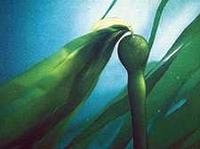Kelp
KELP is the common name for a number of species of large brown SEAWEED. It grows thickly on the rocky Pacific shore in the subtidal and intertidal zones. In BC the 2 largest types are giant kelp (Macrocystis integrifolia), also known as small perennial kelp, which grows on the outer coast, and bull kelp (Nereocystis luetkeana), which is common on both the inner and outer coasts. Both types grow in thick beds, or "kelp forests," that shelter a wide variety of marine life.
Bull kelp, with its long, hollow, rubbery stem, or stipe, is attached to the sea bottom by holdfasts and ends on the surface in a round float with long brown blades, or fronds, trailing across the water. It is predominantly an annual plant, with much of the biomass removed by winter storms each year. Before it dies it disperses a huge number of zoospores that settle on the ocean floor and begin to grow into microscopic, filamentous male and female gamete-producing plants (gametophytes). In spring the male plantlets produce sperm cells that swim to and fertilize the females. The fertilized kelp then begins to grow rapidly—up to 60 cm a day—and reaches a length of 20 m or more by summer's end. Bull kelp is harvested in BC for use as compost, or to be dried and marketed mainly as a health food.
Giant kelp, a perennial plant, is even bigger: its main stipe may grow to more than 33 m in length. As well, it has long, leaf-like blades with pointed tips. Giant kelp is harvested for use in the lucrative HERRING roe-on-kelp fishery each spring. Most of that product is exported to Japan. Small amounts are harvested at other times of the year for fertilizer. Giant kelp is often called small perennial kelp to distinguish it from the related giant kelp (Macricystis pyrifera), which is harvested in California and used in the production of kelp tablets and other products.
Kelp was once much more abundant on the BC coast than it is today. In the early decades of the 19th century, when maritime FUR TRADERS hunted SEA OTTERS almost to extinction, SEA URCHINS, the favoured food of the otter, expanded in population. Urchins feed on kelp; as they spread they laid waste to the vast forests of kelp that once grew on the coast. Following the reintroduction of sea otter and the subsequent depletion of urchins, many kelp beds have recovered. The commercial DIVE FISHERY for red sea urchins has also led to the expansion of kelp beds.

